Curtin University HLPR6013 Health Promotion Report: Key Aspects
VerifiedAdded on 2023/03/21
|7
|1754
|81
Report
AI Summary
This report, prepared for HLPR6013 at Curtin University, delves into the complexities of health promotion. It critically examines the limitations of lifestyle and behavior change programs, highlighting challenges such as technological constraints, resource limitations, and potential policy conflicts. The report then emphasizes the crucial role of community participation in health promotion, defining it as the involvement of individuals in solving their own health-related problems. It explores the benefits of community involvement, including improved problem-solving skills and health outcomes. The report references key principles of community participation, such as community-driven priority setting. It also discusses the significance of community participation from a health promotion perspective and analyzes how it facilitates decision-making, while acknowledging the various barriers to achieving high levels of community involvement due to economic, political, and organizational factors. The report concludes by underscoring the importance of community participation and empowerment as key strategies for achieving greater health equity.
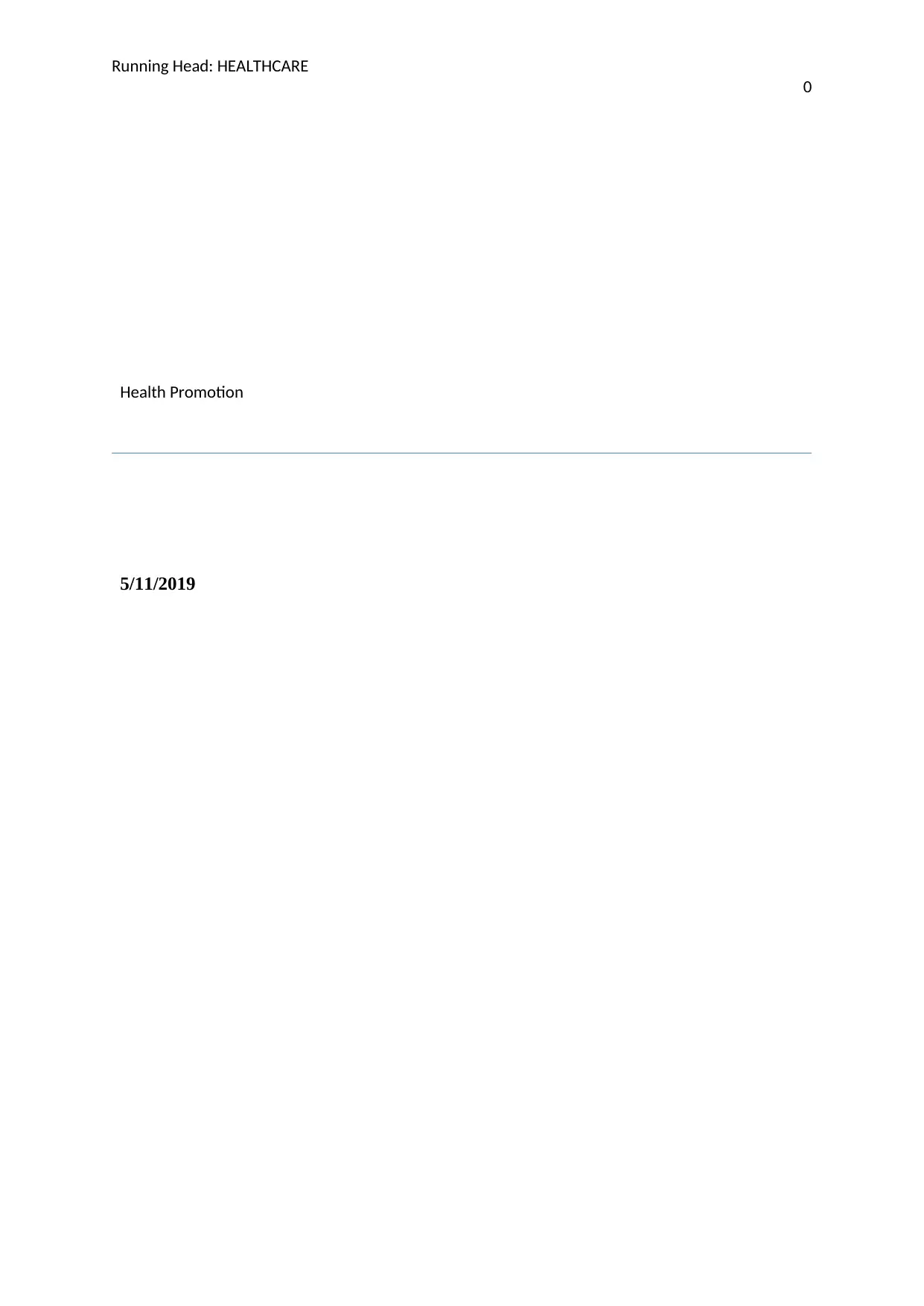
Running Head: HEALTHCARE
0
Health Promotion
5/11/2019
0
Health Promotion
5/11/2019
Paraphrase This Document
Need a fresh take? Get an instant paraphrase of this document with our AI Paraphraser

HEALTHCARE
1
Contents
Q1. Limitations of a focus on the lifestyle and behaviour change programs for improving the health of
population..............................................................................................................................................2
Q2. Importance of community participation from a health promotion perspective................................3
References.............................................................................................................................................5
1
Contents
Q1. Limitations of a focus on the lifestyle and behaviour change programs for improving the health of
population..............................................................................................................................................2
Q2. Importance of community participation from a health promotion perspective................................3
References.............................................................................................................................................5
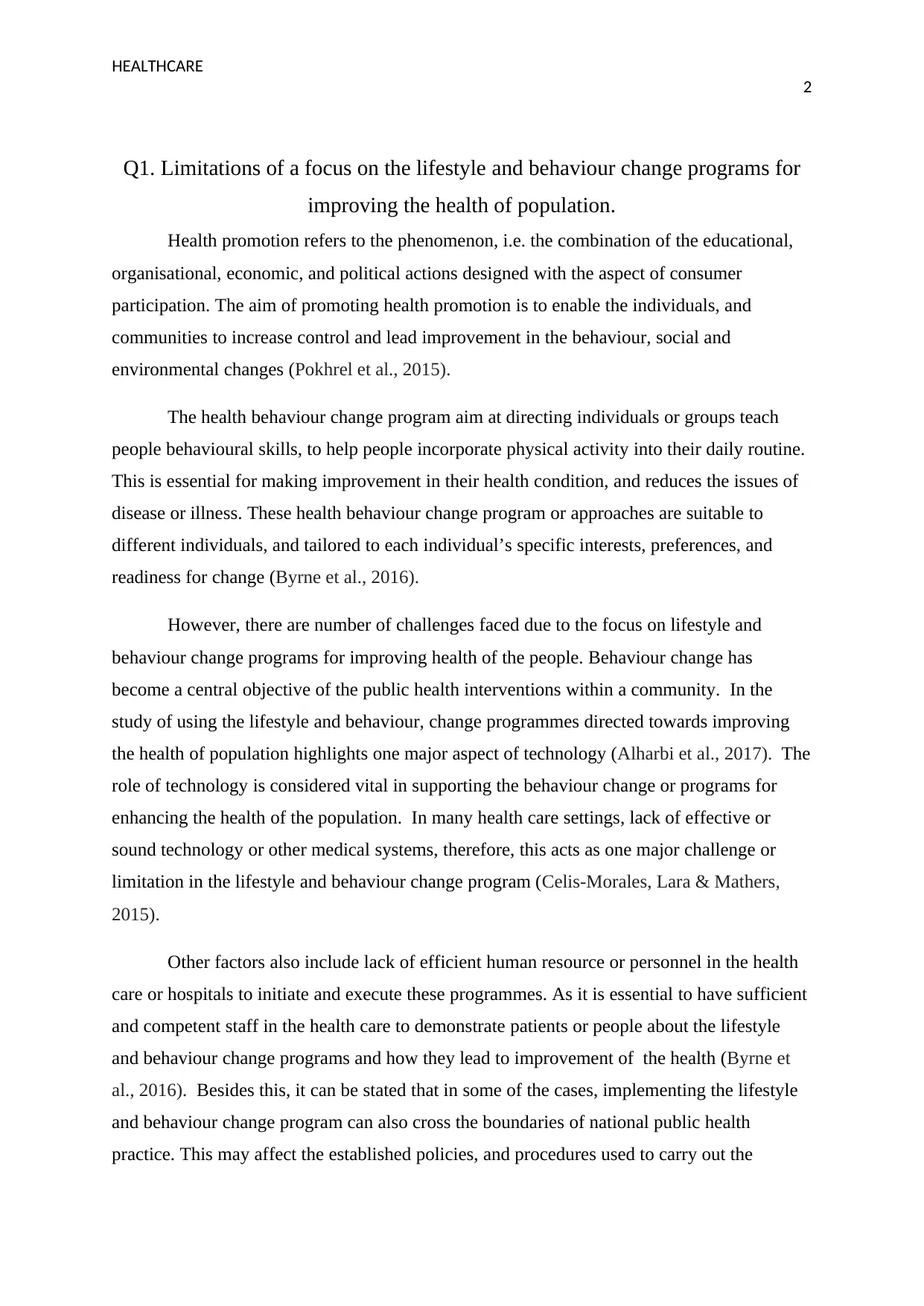
HEALTHCARE
2
Q1. Limitations of a focus on the lifestyle and behaviour change programs for
improving the health of population.
Health promotion refers to the phenomenon, i.e. the combination of the educational,
organisational, economic, and political actions designed with the aspect of consumer
participation. The aim of promoting health promotion is to enable the individuals, and
communities to increase control and lead improvement in the behaviour, social and
environmental changes (Pokhrel et al., 2015).
The health behaviour change program aim at directing individuals or groups teach
people behavioural skills, to help people incorporate physical activity into their daily routine.
This is essential for making improvement in their health condition, and reduces the issues of
disease or illness. These health behaviour change program or approaches are suitable to
different individuals, and tailored to each individual’s specific interests, preferences, and
readiness for change (Byrne et al., 2016).
However, there are number of challenges faced due to the focus on lifestyle and
behaviour change programs for improving health of the people. Behaviour change has
become a central objective of the public health interventions within a community. In the
study of using the lifestyle and behaviour, change programmes directed towards improving
the health of population highlights one major aspect of technology (Alharbi et al., 2017). The
role of technology is considered vital in supporting the behaviour change or programs for
enhancing the health of the population. In many health care settings, lack of effective or
sound technology or other medical systems, therefore, this acts as one major challenge or
limitation in the lifestyle and behaviour change program (Celis-Morales, Lara & Mathers,
2015).
Other factors also include lack of efficient human resource or personnel in the health
care or hospitals to initiate and execute these programmes. As it is essential to have sufficient
and competent staff in the health care to demonstrate patients or people about the lifestyle
and behaviour change programs and how they lead to improvement of the health (Byrne et
al., 2016). Besides this, it can be stated that in some of the cases, implementing the lifestyle
and behaviour change program can also cross the boundaries of national public health
practice. This may affect the established policies, and procedures used to carry out the
2
Q1. Limitations of a focus on the lifestyle and behaviour change programs for
improving the health of population.
Health promotion refers to the phenomenon, i.e. the combination of the educational,
organisational, economic, and political actions designed with the aspect of consumer
participation. The aim of promoting health promotion is to enable the individuals, and
communities to increase control and lead improvement in the behaviour, social and
environmental changes (Pokhrel et al., 2015).
The health behaviour change program aim at directing individuals or groups teach
people behavioural skills, to help people incorporate physical activity into their daily routine.
This is essential for making improvement in their health condition, and reduces the issues of
disease or illness. These health behaviour change program or approaches are suitable to
different individuals, and tailored to each individual’s specific interests, preferences, and
readiness for change (Byrne et al., 2016).
However, there are number of challenges faced due to the focus on lifestyle and
behaviour change programs for improving health of the people. Behaviour change has
become a central objective of the public health interventions within a community. In the
study of using the lifestyle and behaviour, change programmes directed towards improving
the health of population highlights one major aspect of technology (Alharbi et al., 2017). The
role of technology is considered vital in supporting the behaviour change or programs for
enhancing the health of the population. In many health care settings, lack of effective or
sound technology or other medical systems, therefore, this acts as one major challenge or
limitation in the lifestyle and behaviour change program (Celis-Morales, Lara & Mathers,
2015).
Other factors also include lack of efficient human resource or personnel in the health
care or hospitals to initiate and execute these programmes. As it is essential to have sufficient
and competent staff in the health care to demonstrate patients or people about the lifestyle
and behaviour change programs and how they lead to improvement of the health (Byrne et
al., 2016). Besides this, it can be stated that in some of the cases, implementing the lifestyle
and behaviour change program can also cross the boundaries of national public health
practice. This may affect the established policies, and procedures used to carry out the
⊘ This is a preview!⊘
Do you want full access?
Subscribe today to unlock all pages.

Trusted by 1+ million students worldwide
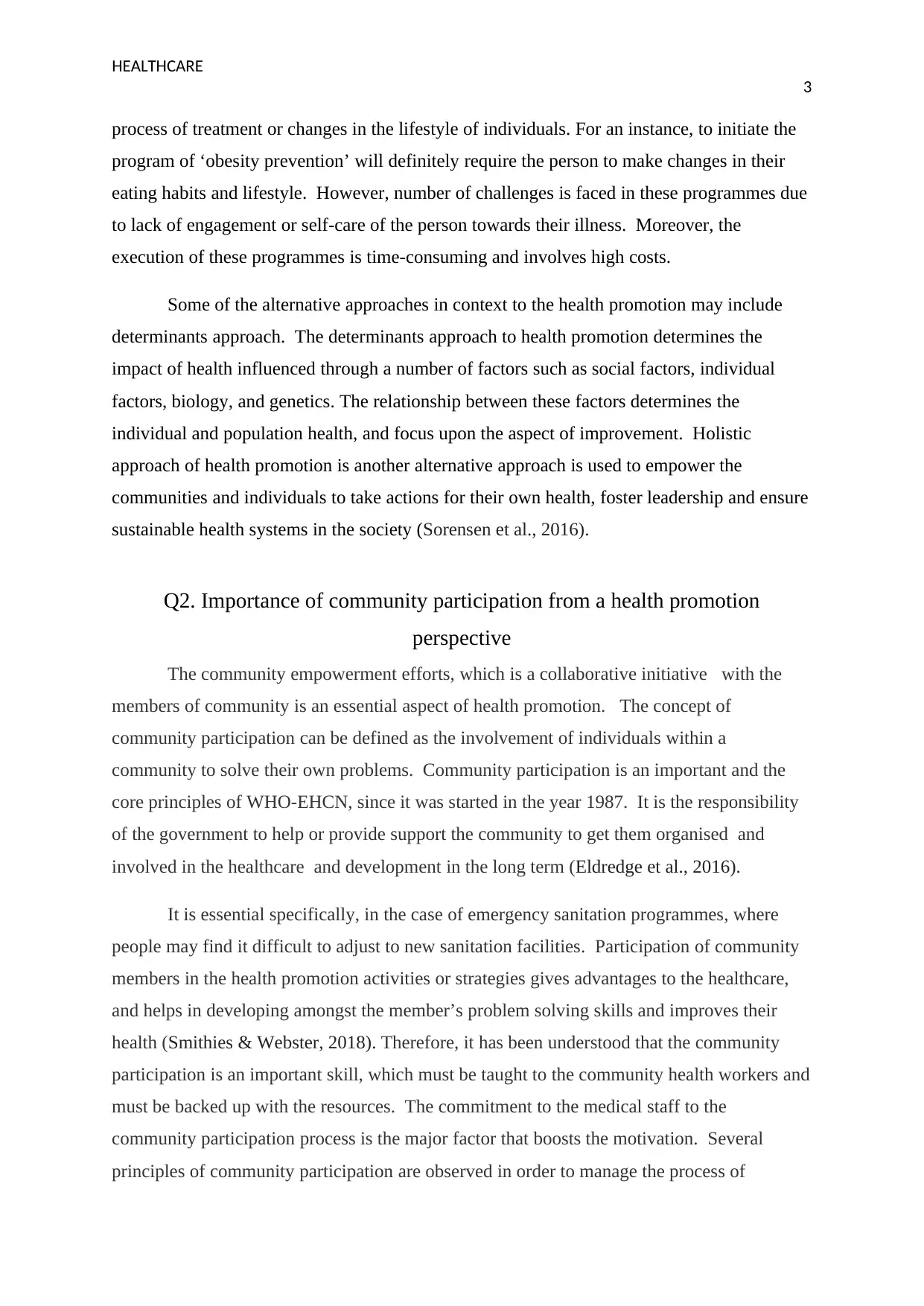
HEALTHCARE
3
process of treatment or changes in the lifestyle of individuals. For an instance, to initiate the
program of ‘obesity prevention’ will definitely require the person to make changes in their
eating habits and lifestyle. However, number of challenges is faced in these programmes due
to lack of engagement or self-care of the person towards their illness. Moreover, the
execution of these programmes is time-consuming and involves high costs.
Some of the alternative approaches in context to the health promotion may include
determinants approach. The determinants approach to health promotion determines the
impact of health influenced through a number of factors such as social factors, individual
factors, biology, and genetics. The relationship between these factors determines the
individual and population health, and focus upon the aspect of improvement. Holistic
approach of health promotion is another alternative approach is used to empower the
communities and individuals to take actions for their own health, foster leadership and ensure
sustainable health systems in the society (Sorensen et al., 2016).
Q2. Importance of community participation from a health promotion
perspective
The community empowerment efforts, which is a collaborative initiative with the
members of community is an essential aspect of health promotion. The concept of
community participation can be defined as the involvement of individuals within a
community to solve their own problems. Community participation is an important and the
core principles of WHO-EHCN, since it was started in the year 1987. It is the responsibility
of the government to help or provide support the community to get them organised and
involved in the healthcare and development in the long term (Eldredge et al., 2016).
It is essential specifically, in the case of emergency sanitation programmes, where
people may find it difficult to adjust to new sanitation facilities. Participation of community
members in the health promotion activities or strategies gives advantages to the healthcare,
and helps in developing amongst the member’s problem solving skills and improves their
health (Smithies & Webster, 2018). Therefore, it has been understood that the community
participation is an important skill, which must be taught to the community health workers and
must be backed up with the resources. The commitment to the medical staff to the
community participation process is the major factor that boosts the motivation. Several
principles of community participation are observed in order to manage the process of
3
process of treatment or changes in the lifestyle of individuals. For an instance, to initiate the
program of ‘obesity prevention’ will definitely require the person to make changes in their
eating habits and lifestyle. However, number of challenges is faced in these programmes due
to lack of engagement or self-care of the person towards their illness. Moreover, the
execution of these programmes is time-consuming and involves high costs.
Some of the alternative approaches in context to the health promotion may include
determinants approach. The determinants approach to health promotion determines the
impact of health influenced through a number of factors such as social factors, individual
factors, biology, and genetics. The relationship between these factors determines the
individual and population health, and focus upon the aspect of improvement. Holistic
approach of health promotion is another alternative approach is used to empower the
communities and individuals to take actions for their own health, foster leadership and ensure
sustainable health systems in the society (Sorensen et al., 2016).
Q2. Importance of community participation from a health promotion
perspective
The community empowerment efforts, which is a collaborative initiative with the
members of community is an essential aspect of health promotion. The concept of
community participation can be defined as the involvement of individuals within a
community to solve their own problems. Community participation is an important and the
core principles of WHO-EHCN, since it was started in the year 1987. It is the responsibility
of the government to help or provide support the community to get them organised and
involved in the healthcare and development in the long term (Eldredge et al., 2016).
It is essential specifically, in the case of emergency sanitation programmes, where
people may find it difficult to adjust to new sanitation facilities. Participation of community
members in the health promotion activities or strategies gives advantages to the healthcare,
and helps in developing amongst the member’s problem solving skills and improves their
health (Smithies & Webster, 2018). Therefore, it has been understood that the community
participation is an important skill, which must be taught to the community health workers and
must be backed up with the resources. The commitment to the medical staff to the
community participation process is the major factor that boosts the motivation. Several
principles of community participation are observed in order to manage the process of
Paraphrase This Document
Need a fresh take? Get an instant paraphrase of this document with our AI Paraphraser
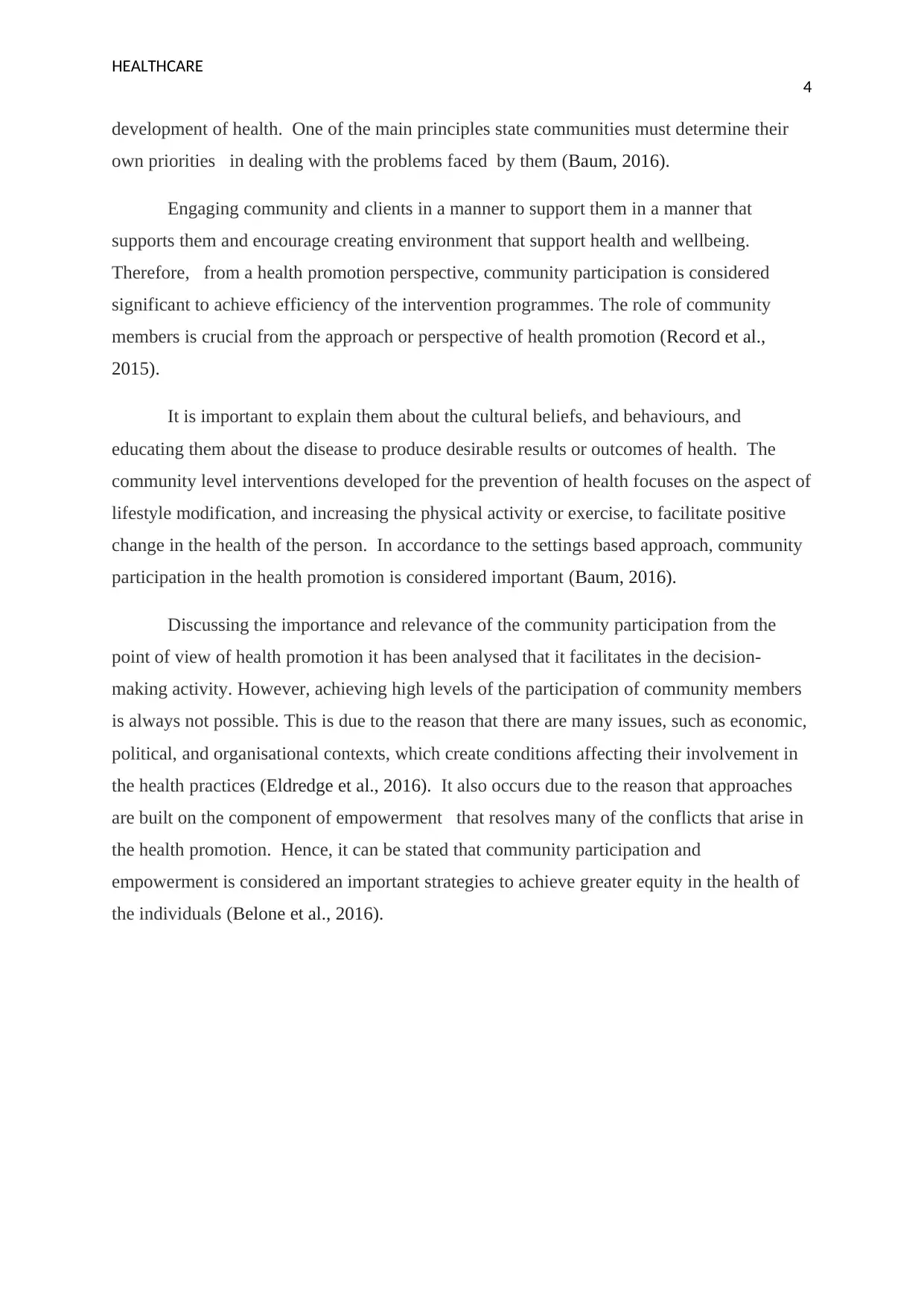
HEALTHCARE
4
development of health. One of the main principles state communities must determine their
own priorities in dealing with the problems faced by them (Baum, 2016).
Engaging community and clients in a manner to support them in a manner that
supports them and encourage creating environment that support health and wellbeing.
Therefore, from a health promotion perspective, community participation is considered
significant to achieve efficiency of the intervention programmes. The role of community
members is crucial from the approach or perspective of health promotion (Record et al.,
2015).
It is important to explain them about the cultural beliefs, and behaviours, and
educating them about the disease to produce desirable results or outcomes of health. The
community level interventions developed for the prevention of health focuses on the aspect of
lifestyle modification, and increasing the physical activity or exercise, to facilitate positive
change in the health of the person. In accordance to the settings based approach, community
participation in the health promotion is considered important (Baum, 2016).
Discussing the importance and relevance of the community participation from the
point of view of health promotion it has been analysed that it facilitates in the decision-
making activity. However, achieving high levels of the participation of community members
is always not possible. This is due to the reason that there are many issues, such as economic,
political, and organisational contexts, which create conditions affecting their involvement in
the health practices (Eldredge et al., 2016). It also occurs due to the reason that approaches
are built on the component of empowerment that resolves many of the conflicts that arise in
the health promotion. Hence, it can be stated that community participation and
empowerment is considered an important strategies to achieve greater equity in the health of
the individuals (Belone et al., 2016).
4
development of health. One of the main principles state communities must determine their
own priorities in dealing with the problems faced by them (Baum, 2016).
Engaging community and clients in a manner to support them in a manner that
supports them and encourage creating environment that support health and wellbeing.
Therefore, from a health promotion perspective, community participation is considered
significant to achieve efficiency of the intervention programmes. The role of community
members is crucial from the approach or perspective of health promotion (Record et al.,
2015).
It is important to explain them about the cultural beliefs, and behaviours, and
educating them about the disease to produce desirable results or outcomes of health. The
community level interventions developed for the prevention of health focuses on the aspect of
lifestyle modification, and increasing the physical activity or exercise, to facilitate positive
change in the health of the person. In accordance to the settings based approach, community
participation in the health promotion is considered important (Baum, 2016).
Discussing the importance and relevance of the community participation from the
point of view of health promotion it has been analysed that it facilitates in the decision-
making activity. However, achieving high levels of the participation of community members
is always not possible. This is due to the reason that there are many issues, such as economic,
political, and organisational contexts, which create conditions affecting their involvement in
the health practices (Eldredge et al., 2016). It also occurs due to the reason that approaches
are built on the component of empowerment that resolves many of the conflicts that arise in
the health promotion. Hence, it can be stated that community participation and
empowerment is considered an important strategies to achieve greater equity in the health of
the individuals (Belone et al., 2016).
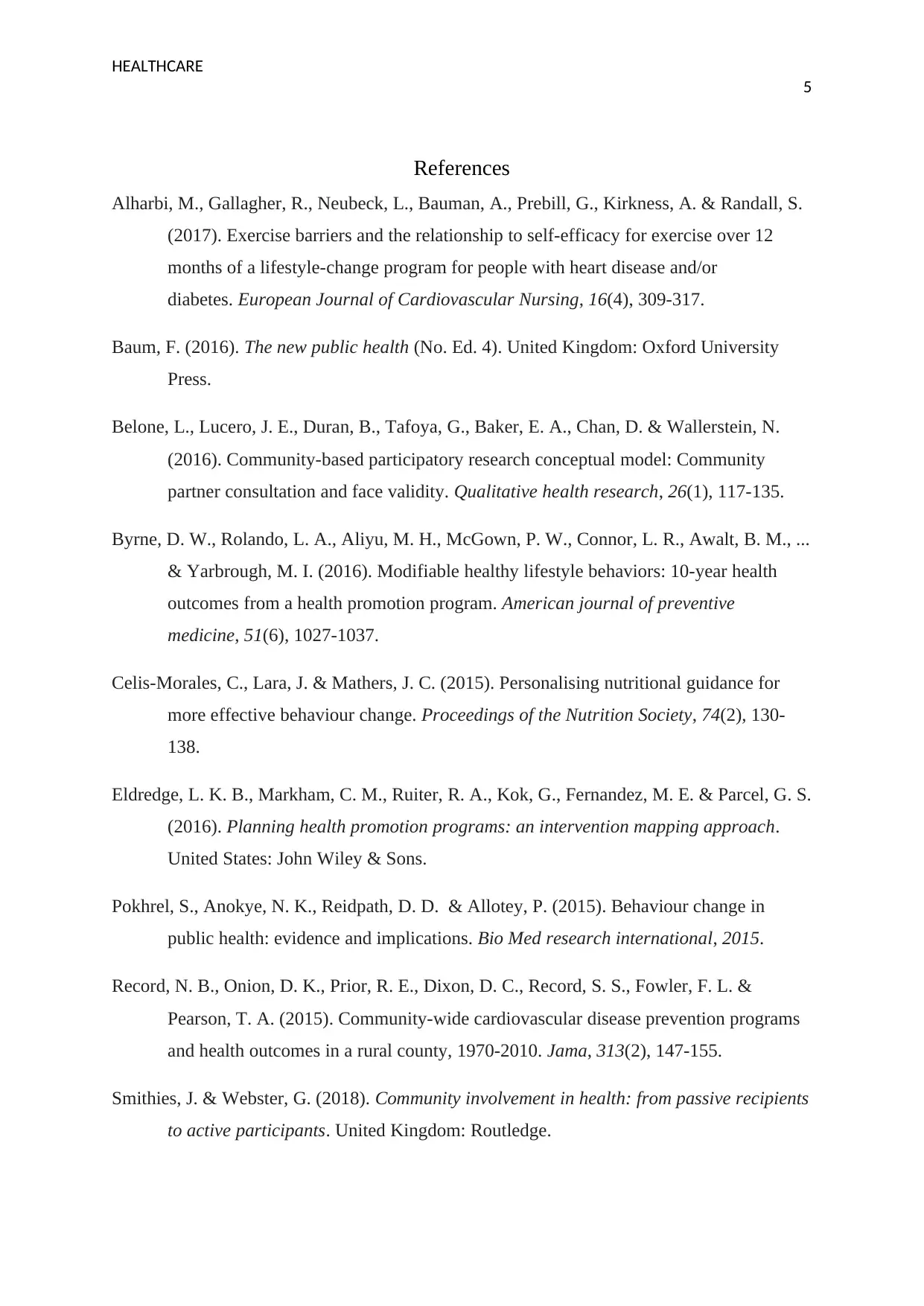
HEALTHCARE
5
References
Alharbi, M., Gallagher, R., Neubeck, L., Bauman, A., Prebill, G., Kirkness, A. & Randall, S.
(2017). Exercise barriers and the relationship to self-efficacy for exercise over 12
months of a lifestyle-change program for people with heart disease and/or
diabetes. European Journal of Cardiovascular Nursing, 16(4), 309-317.
Baum, F. (2016). The new public health (No. Ed. 4). United Kingdom: Oxford University
Press.
Belone, L., Lucero, J. E., Duran, B., Tafoya, G., Baker, E. A., Chan, D. & Wallerstein, N.
(2016). Community-based participatory research conceptual model: Community
partner consultation and face validity. Qualitative health research, 26(1), 117-135.
Byrne, D. W., Rolando, L. A., Aliyu, M. H., McGown, P. W., Connor, L. R., Awalt, B. M., ...
& Yarbrough, M. I. (2016). Modifiable healthy lifestyle behaviors: 10-year health
outcomes from a health promotion program. American journal of preventive
medicine, 51(6), 1027-1037.
Celis-Morales, C., Lara, J. & Mathers, J. C. (2015). Personalising nutritional guidance for
more effective behaviour change. Proceedings of the Nutrition Society, 74(2), 130-
138.
Eldredge, L. K. B., Markham, C. M., Ruiter, R. A., Kok, G., Fernandez, M. E. & Parcel, G. S.
(2016). Planning health promotion programs: an intervention mapping approach.
United States: John Wiley & Sons.
Pokhrel, S., Anokye, N. K., Reidpath, D. D. & Allotey, P. (2015). Behaviour change in
public health: evidence and implications. Bio Med research international, 2015.
Record, N. B., Onion, D. K., Prior, R. E., Dixon, D. C., Record, S. S., Fowler, F. L. &
Pearson, T. A. (2015). Community-wide cardiovascular disease prevention programs
and health outcomes in a rural county, 1970-2010. Jama, 313(2), 147-155.
Smithies, J. & Webster, G. (2018). Community involvement in health: from passive recipients
to active participants. United Kingdom: Routledge.
5
References
Alharbi, M., Gallagher, R., Neubeck, L., Bauman, A., Prebill, G., Kirkness, A. & Randall, S.
(2017). Exercise barriers and the relationship to self-efficacy for exercise over 12
months of a lifestyle-change program for people with heart disease and/or
diabetes. European Journal of Cardiovascular Nursing, 16(4), 309-317.
Baum, F. (2016). The new public health (No. Ed. 4). United Kingdom: Oxford University
Press.
Belone, L., Lucero, J. E., Duran, B., Tafoya, G., Baker, E. A., Chan, D. & Wallerstein, N.
(2016). Community-based participatory research conceptual model: Community
partner consultation and face validity. Qualitative health research, 26(1), 117-135.
Byrne, D. W., Rolando, L. A., Aliyu, M. H., McGown, P. W., Connor, L. R., Awalt, B. M., ...
& Yarbrough, M. I. (2016). Modifiable healthy lifestyle behaviors: 10-year health
outcomes from a health promotion program. American journal of preventive
medicine, 51(6), 1027-1037.
Celis-Morales, C., Lara, J. & Mathers, J. C. (2015). Personalising nutritional guidance for
more effective behaviour change. Proceedings of the Nutrition Society, 74(2), 130-
138.
Eldredge, L. K. B., Markham, C. M., Ruiter, R. A., Kok, G., Fernandez, M. E. & Parcel, G. S.
(2016). Planning health promotion programs: an intervention mapping approach.
United States: John Wiley & Sons.
Pokhrel, S., Anokye, N. K., Reidpath, D. D. & Allotey, P. (2015). Behaviour change in
public health: evidence and implications. Bio Med research international, 2015.
Record, N. B., Onion, D. K., Prior, R. E., Dixon, D. C., Record, S. S., Fowler, F. L. &
Pearson, T. A. (2015). Community-wide cardiovascular disease prevention programs
and health outcomes in a rural county, 1970-2010. Jama, 313(2), 147-155.
Smithies, J. & Webster, G. (2018). Community involvement in health: from passive recipients
to active participants. United Kingdom: Routledge.
⊘ This is a preview!⊘
Do you want full access?
Subscribe today to unlock all pages.

Trusted by 1+ million students worldwide

HEALTHCARE
6
Sorensen, G., McLellan, D. L., Sabbath, E. L., Dennerlein, J. T., Nagler, E. M., Hurtado, D.
A. & Wagner, G. R. (2016). Integrating worksite health protection and health
promotion: a conceptual model for intervention and research. Preventive
medicine, 91, 188-196.
6
Sorensen, G., McLellan, D. L., Sabbath, E. L., Dennerlein, J. T., Nagler, E. M., Hurtado, D.
A. & Wagner, G. R. (2016). Integrating worksite health protection and health
promotion: a conceptual model for intervention and research. Preventive
medicine, 91, 188-196.
1 out of 7
Related Documents
Your All-in-One AI-Powered Toolkit for Academic Success.
+13062052269
info@desklib.com
Available 24*7 on WhatsApp / Email
![[object Object]](/_next/static/media/star-bottom.7253800d.svg)
Unlock your academic potential
Copyright © 2020–2025 A2Z Services. All Rights Reserved. Developed and managed by ZUCOL.



